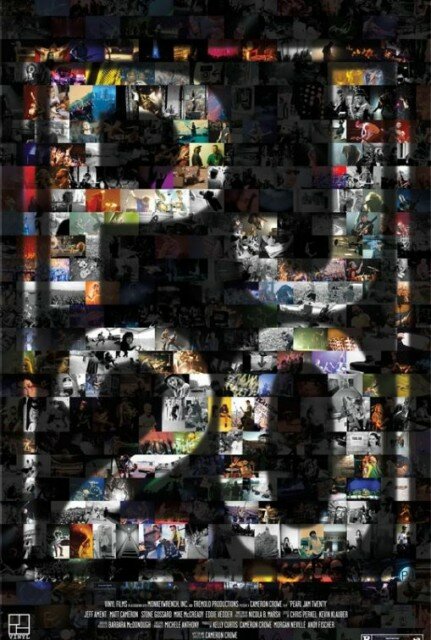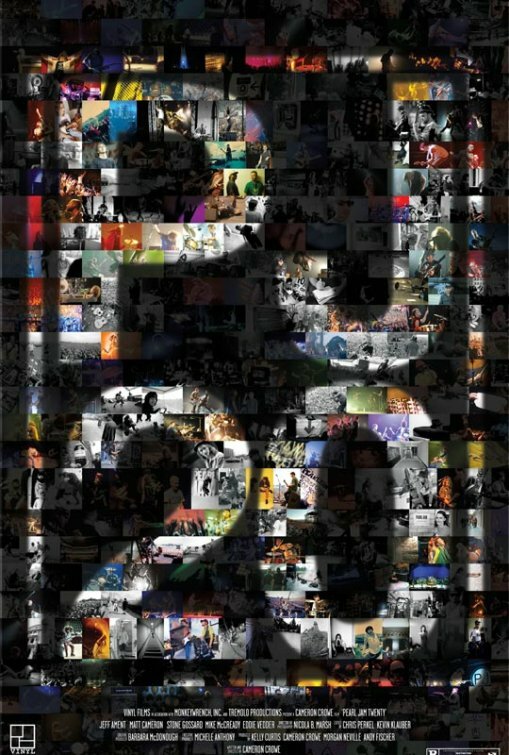If I had filmmaking talent and had befriended Pearl Jam’s members when they called themselves “Mookie Blaylock,” the movie I’d make about their career today would be a lot like Pearl Jam Twenty. Director Cameron Crowe (who palled around with the guys and first put them on the big screen in 1991’s Singles) essentially says in an early voiceover that his film is a love letter to the band. Like most love letters, PJ20 focuses on the positive qualities of its paramour, jumps around with giddy scatterbrained emotion, and wraps up with misty hope that the relationship has only just begun. It’s sweet. It’s funny. It’s moving. And it rocks.

What I would do differently is tack another hour on the near-120-minute running time—maybe move some scenes around, too—and dig deeper into some of the career-shaping decisions and events that Crowe holds up for us to admire, and then, like an enviably proud kid at show-and-tell, excitedly replaces with something else.
The director addresses most of the elements even non-fans associate with Pearl Jam, in (somewhat) chronological order, via a scrapbook-like amalgamation of old and new interviews, band home movies, candid and concert footage dating back to 1989, and craftily-edited vignettes. The early “feud” with Nirvana; guitarist Mike McCready’s struggle with addiction; the Ticketmaster battle; the lack of commercial music videos; the Binaural-era near-breakup; the tragedy at Roskilde; the Grateful Dead-ish tour following; the political causes borne like battle flags; the myriad and ceaseless philanthropic efforts.
But most of those topic segments—even Roskilde, where nine Denmark festival attendees were killed in a crowd surge in 2000—don’t feel quite rounded out. (However, we do see frontman Eddie Vedder weeping, on a massive screen flanking the stage, immediately following the incomprehensible crush. It’s a profoundly sad inclusion on a topic that could easily spawn Pearl Jam’s own Gimme Shelter.) It’s hard to imagine that the band didn’t have more to say on that; I’ve read stories about guitarist Stone Gossard and Vedder’s ongoing relationship with the victims’ families. And it’s clear, in Crowe’s recent interviews with those two members, that the event has become a part of their daily emotional lives.
So maybe that awful event and McCready’s struggles—which the axeman alludes to briefly a couple of times—were considered too heavy? Maybe a summation of the Ticketmaster-free tour and antitrust testimony outcome—essentially one for the loss column, thanks to a closed government investigation—would have seemed too neat? Maybe Pearl Jam, which has impressively managed its image since the beginning, wanted to accentuate the positive? Or Crowe’s lighthearted tendencies (see his resume) steered him clear of true exploration of the tough stuff? Who knows?
Perhaps the deluxe Blu-ray edition of the film, out October 25 and only available via the band’s site, will answer these questions. It’s loaded with hours of extras.
Even more curious than these surface-scratching segments are the omissions of other Pearl Jam trademarks and topics of fan speculation. The fanatic-satiating bootleg program. The Monkeywrench label the band has published itself under for years. The side projects each member has been involved with. The Ten Club, without which demand for projects like this very film would be far less fervent. These missing aspects frankly feel like oversights—though most casual fans likely won’t miss them—and I’d make them the bulk of my additional hour.
Does it sound like I’m complaining? I’m not. (In fact, my hunch is that the film was never intended to be exhaustive; thus the companion print retrospective of the same name. Discuss.) PJ20 paints a fairly complete portrait of the band, from its formation in the wake of Mother Love Bone’s demise (following Andy Wood’s scene-shaking 1990 death); to its near-immediate success with debut record Ten; to its attempts (fueled mainly by Vedder) to sidestep the resulting mainstream spotlight; to its carefully-crafted redefinition of what rock stardom can be. It’s a satisfying look at who Vedder, Gossard, bassist Jeff Ament, McCready, and drummer Matt Cameron are, how they’ve always focused on their art and its impact on its listeners, instead of sales and awards—and how their individual characters and talents have influenced PJ’s evolution.
Like a typically greedy, insatiable superfan,* though, I wanted more from the film. More, even though there are dozens of surprising/revealing/intimate moments and scenes like these:
- McCready on Gossard’s reaction to possibly playing with Ament in another band after Mother Love Bone: “He was like, ‘Fuck that guy.’”
- Cornell, recalling the late Wood’s innocent enthusiasm and ingrained desire to rock arena crowds, barely holds back tears.
- Gossard, on initially hearing Vedder’s contribution to Temple of the Dog’s “Going Hungry,” with Chris Cornell leading vocals: “Our guy is pretty fucking good, too!”
- Vedder, who tosses himself into one crowd after another in early ’90s live footage, says that the line between who’s on stage and who’s in the crowd has always been a blurry one.
- Ament puts on a Ramones record and sits down with his bass to strum Dee Dee’s parts, explaining in voiceover that was how he learned to play punk.
- An eyewitness describes how, at an early show, a security staffer drew Vedder’s ire when the former got too rough with a fan. The witness says that this occurrence changed the singer—broke him from a shy shell that had heretofore kept him contained onstage. And amazingly, there’s video: As the young Vedder, belting out lyrics, kneels behind the oblivious security dude at the foot of the stage, his face hardens and his voice takes on a rough, rumbling edge. (This is the scarily intense guy you remember from the “Jeremy” video.) The staffer turns, slowly, and the singer just wails furiously into his face.
- At the Singles party orchestrated to promote the film via MTV, Vedder drunkenly curses and shouts and stumbles through a terrible live performance. It’s funny now—and a treat to see after all these years—but clear that the band would rather forget that tequila-fueled night.
- Cameron comments on being invited into the PJ fold shortly before a tour, joking—but serious—about having to learn 60 or 70 songs in a matter of weeks. (It’s no wonder the other guys fawn over him.)
- Gossard digs around a couple of rooms in his home, looking for the small bit of band paraphernalia he’s kept over the years. Finding only a few books and CDs, he goes to the basement. “Look, there’s a Grammy!” It’s in a corner, forgotten and dusty.
Recent live performances of “Better Man” and “Alive” close the film—quite appropriately and triumphantly. Following the swooping opening notes of the former, Vedder stands silently at the mic as the crowd, a sea of lighter flames, handles the vocals. It’s beautiful—and not a novelty; at every show I’ve attended, the crowd sings at least a few verses for Vedder. It’s nearly as powerful on film (likely thanks in part to the Cinerama’s immersive sound system). As the band tears through the latter—and Cameron’s fusillades, Ament’s snaking bass, and McCready’s shredding absolutely shine—Crowe intercuts the band’s earliest performances of the song, when Vedder climbed rigging and tossed himself perilously into crowds, and the naivety and frustration of youth fueled every note. Where are they now? Still on stage, doing it with as much energy and emotion as ever.
Pearl Jam Twenty is vastly entertaining (if not exactly exhaustive) evidence that while technology and tour practices and popular culture have changed, one thing has remained unequivocal since 1990: Pearl Jam’s relationship with its fans. It’s a comfortable connection that has, if anything, become dependent over two decades—in the best sense of the word. We need Pearl Jam to tour and make new music. The band needs us to show up, listen, sing along, and keep the line blurred.
And I need to buff up on the old film school wisdom, befriend the guys, and get to work.
In the meantime, if you didn’t catch the film at its short Cinerama run, tune in to PBS at 9 p.m. on Friday, October 21 for an American Masters airing of Pearl Jam Twenty.
*I’m not the kind of superfan that takes repeated flash photos during a movie, shouts band members’ names every time they appear on screen, or conspicuously peels movie posters off the theater wall with an ain’t-I-cool? grin. Come on, people.
